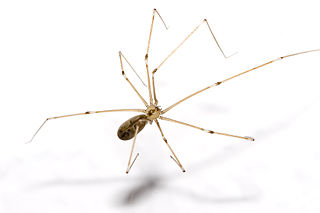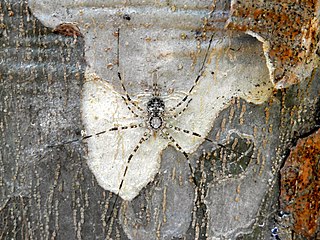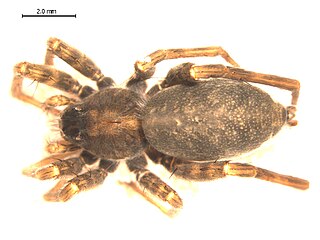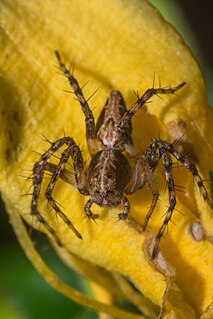
The Pholcidae are a family of araneomorph spiders. The family contains over 1,800 pholcids, including those commonly known as the marbled cellar spider , daddy long-legs spider, granddaddy long-legs spider, carpenter spider, daddy long-legger, vibrating spider, gyrating spider, long daddy, and skull spider. The family, first described by Carl Ludwig Koch in 1850, is divided into 94 genera.

The Agelenidae are a large family of spiders in the suborder Araneomorphae. Well-known examples include the common "grass spiders" of the genus Agelenopsis. Nearly all Agelenidae are harmless to humans, but the bite of the hobo spider may be medically significant, and some evidence suggests it might cause necrotic lesions. However, the matter remains subject to debate. The most widely accepted common name for members of the family is funnel weaver.
Barronopsis is a genus of funnel weavers first described by R. V. Chamberlin & Ivie in 1941.
Calilena is a genus of North American funnel weavers first described by R. V. Chamberlin & Wilton Ivie in 1941.
Calilena restricta is a species of funnel weaver in the family of spiders known as Agelenidae. It is found in the USA.

Neotama mexicana, also known as the long-spinneret spider or Mexican two-tailed spider, is a species of tree trunk spider in the family Hersiliidae. It is found in a range from the United States to Peru and Guyana.

Hentzia mitrata, the white-jawed jumping spider, is a species of jumping spider in the family Salticidae. It is found in the United States, Canada, and Bahama Islands.
Pityohyphantes costatus, the hammock spider, is a species of sheetweb spider in the family Linyphiidae. It is found in the United States.
Ceraticelus emertoni is a species of dwarf spider in the family Linyphiidae. It is found in the United States.

Pardosa lapidicina, the stone spider, is a species of wolf spider in the family Lycosidae. It is found in the United States and Canada.
Xysticus emertoni, or Emerton's crab spider, is a species of crab spider in the family Thomisidae. It is found in the United States, Canada, Slovakia, Russia, and a range from Central Asia to China.

Pirata piraticus is a species of wolf spider in the family Lycosidae. It is found in North America, Europe, Turkey, Caucasus, a range from Russia, Central Asia, China, and Japan.
Ceraticelus similis is a species of dwarf spider in the family Linyphiidae. It is found in the United States.

Theridion murarium is a species of cobweb spider in the family Theridiidae. It is found in North America.
Habronattus tranquillus is a species of jumping spider in the family Salticidae. It is found in the United States and Mexico.
Phrurotimpus borealis is a species of true spider in the family Phrurolithidae. It is found in North America.

Phidippus apacheanus is a species of jumping spider in the family Salticidae. It is found in the United States, Mexico, and Cuba.
Kaestneria pullata is a species of sheetweb spider in the family Linyphiidae. It is found in North America, Europe, a range from Russia, China, Mongolia, and Japan.

Oxyopes scalaris, the western lynx spider, is a species of lynx spider in the family Oxyopidae. It is found in North America.

Pholcus manueli, known generally as the cellar spider or daddy longlegs, is a species of cellar spider in the family Pholcidae. It is found in Russia, Turkmenistan, China, Korea, Japan, and the United States.









